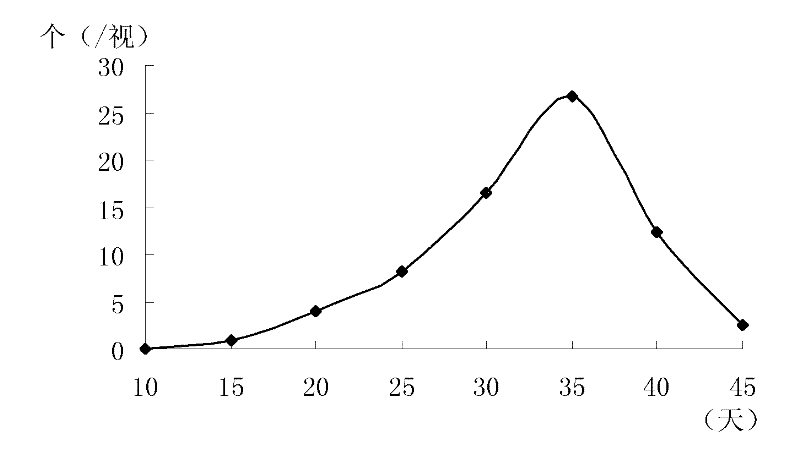Fabrication method of cover glass for conidiospore of Ophio cordyceps sinensis and dynamic counting method of produced conidiospore
A technology of Cordyceps sinensis and conidia, which is applied in the direction of biochemical equipment and methods, measurement/inspection of microorganisms, etc., can solve the problems of long sporulation cycle, low sporulation amount, and poor culture observation and counting, and achieve the goal of working High efficiency, simplified experimental procedures, and good research and application value
- Summary
- Abstract
- Description
- Claims
- Application Information
AI Technical Summary
Problems solved by technology
Method used
Image
Examples
Embodiment 1
[0025] Embodiment 1, Cordyceps sinensis conidia count
[0026] 1. The cultivation of Cordyceps sinensis
[0027] Each 1L of solid medium for Cordyceps sinensis is prepared according to Chinese patent ZL200510137457.8: 50.0 grams of wheat bran, 20.0 grams of glucose, 5.0 grams of peptone, 3.0 grams of yeast extract, 200 grams of potatoes, 18.0 grams of agar, and dilute to 1000 milliliters with water.
[0028] Separation and purification from natural Cordyceps sinensis (see Dong, C.-H. and Yao, Y.-J. (2008). In vitroevaluation of antioxidant activities of aqueous extracts from natural and cultured mycelia of Cordyceps sinensis. LWT-Food Science and Technology 41(4): 669-677.) obtained Ophiocordyceps sinensis strain No. 762, which has been preserved in China General Microorganism Culture Collection Center (CGMCC No.2793), a patent strain.
[0029] Cordyceps sinensis (Ophio cordyceps sinensis) strain 762 was preserved on December 5, 2008 in the General Microbiology Center of Chin...
Embodiment 2
[0038] Embodiment 2, Cordyceps sinensis conidia count
[0039] 1. The cultivation of Cordyceps sinensis
[0040] Each 1L of solid medium for Cordyceps sinensis is prepared according to Chinese patent ZL200510137457.8: 50.0 grams of wheat bran, 20.0 grams of glucose, 5.0 grams of peptone, 3.0 grams of yeast extract, 200 grams of potatoes, 18.0 grams of agar, and dilute to 1000 ml with water.
[0041] Cordyceps fungus strain No. 762 CGMCC No.2793 isolated and purified from natural Cordyceps sinensis.
[0042] The Cordyceps sinensis strain No. 762 obtained by the above isolation and purification was extracted, amplified and sequenced by DNA, and analyzed by using the molecular database dedicated to Cordyceps sinensis, and identified as a true Cordyceps sinensis strain by molecular biology.
[0043] Cordyceps sinensis strain No. 762 CGMCC No.2793 was inoculated in the center of a petri dish containing a solid special medium for Cordyceps sinensis, placed at 18°C, and cultured in th...
Embodiment 3
[0049] Embodiment 3, Cordyceps sinensis conidia count
[0050] 1. The cultivation of Cordyceps sinensis
[0051] Each 1L of solid medium for Cordyceps sinensis is prepared according to Chinese patent ZL200510137457.8: 50.0 grams of wheat bran, 20.0 grams of glucose, 5.0 grams of peptone, 3.0 grams of yeast extract, 200 grams of potatoes, 18.0 grams of agar, and dilute to 1000 ml with water.
[0052] Separation and purification from natural Cordyceps sinensis to obtain Cordyceps sinensis strain No. 762 CGMCC No.2793.
[0053] The Cordyceps sinensis strain No. 762 obtained by the above isolation and purification was extracted, amplified and sequenced by DNA, and analyzed by using the molecular database dedicated to Cordyceps sinensis, and identified as a true Cordyceps sinensis strain by molecular biology.
[0054] Inoculate Cordyceps sinensis strain No. 762 CGMCC No.2793 in the center of a petri dish containing a special solid medium for Cordyceps sinensis, place it at 18°C, a...
PUM
 Login to View More
Login to View More Abstract
Description
Claims
Application Information
 Login to View More
Login to View More - R&D
- Intellectual Property
- Life Sciences
- Materials
- Tech Scout
- Unparalleled Data Quality
- Higher Quality Content
- 60% Fewer Hallucinations
Browse by: Latest US Patents, China's latest patents, Technical Efficacy Thesaurus, Application Domain, Technology Topic, Popular Technical Reports.
© 2025 PatSnap. All rights reserved.Legal|Privacy policy|Modern Slavery Act Transparency Statement|Sitemap|About US| Contact US: help@patsnap.com

